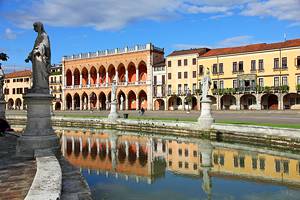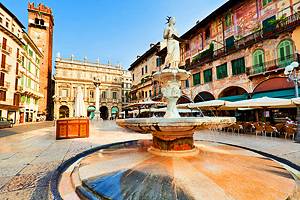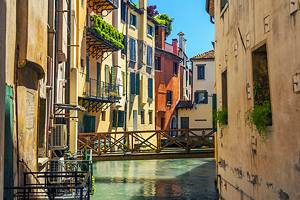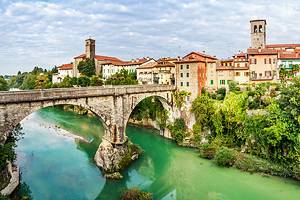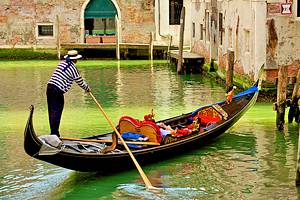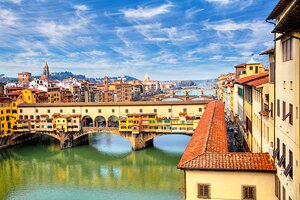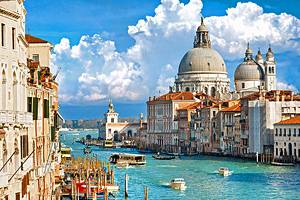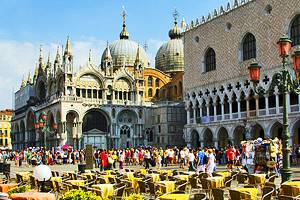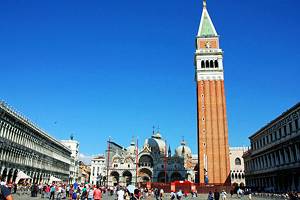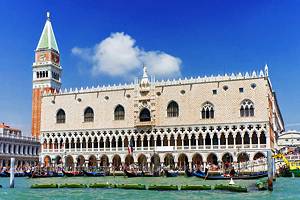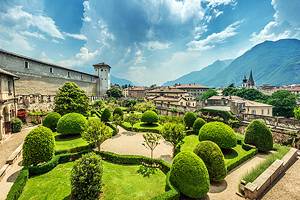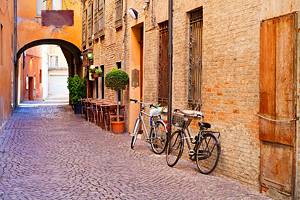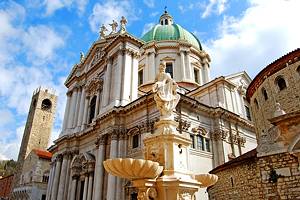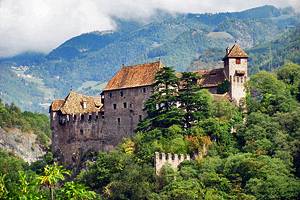Tourist Attractions in Vicenza
About halfway between Verona and Venice, Vicenza lies at the edge of the fertile Po plain, just below the foothills of the Dolomites. Including Vicenza in its World Heritage list, UNESCO cited the work here of Andrea Palladio in the 16th century, "which gives the city its unique appearance."
His work inspired a distinct architectural style known as Palladian, which spread to England and other European countries, and also to North America. Palladian ideals mix freely here with the distinctive Venetian styles, as Vicenza was part of the Venetian empire from 1404 until the late 1700s.
The other name to know in art here is the 15th-century painter Bartolomeo Montagna, whose work you'll see in the Museo Civico and in several churches. Learn more about the city's unique sights with our list of the top tourist attractions and things to do in Vicenza.
Teatro Olimpico
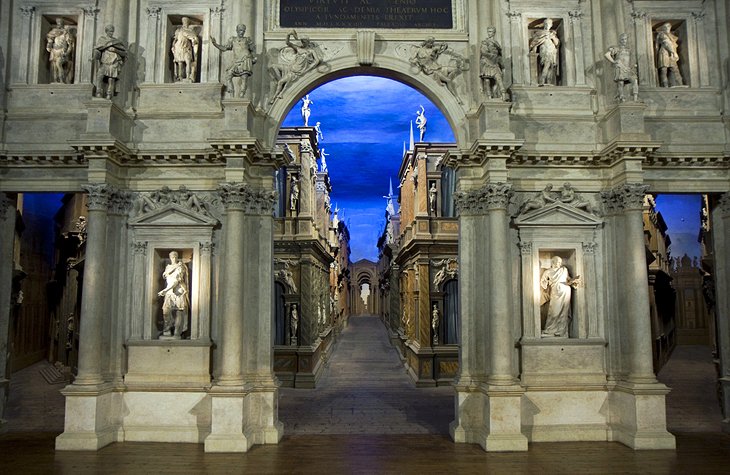
Opposite the Museo Civico, the Teatro Olimpico was begun by Palladio in 1580 and completed in 1584 by Vincenzo Scamozzi, after Palladio's death. Built of wood and stucco, this is a Renaissance adaption of ancient theaters. As you enter the building, be sure to notice its size, and be conscious of the distance you walk inside the theater.
You will be surprised by how large the stage seems. This is a grand illusion, achieved by the clever use of sets that diminish in size to create the effect of long streets running off into the distance. The stage is, in fact, quite shallow.
There is a Vicenza tourism office opposite the theater, with tickets to museums and information on places to visit and things to do in Vicenza.
Address: Piazza Matteotti, I-36100 Vicenza
Basilica Palladiana and Museo Palladiano
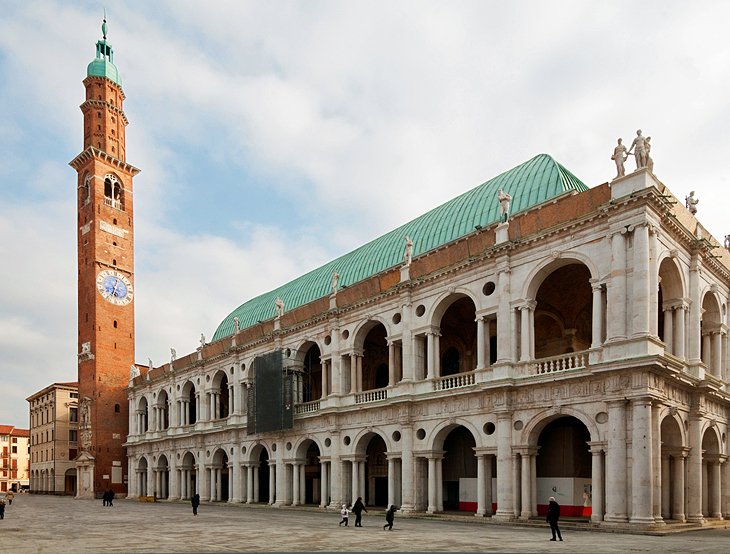
The southeast side of Piazza dei Signori is dominated by the elegant Basilica Palladiana, Palladio's masterpiece, built between 1549 and 1614. Its two stories of open colonnades, the lower part Doric and upper part Ionic, make it impressive but also serve to blend it into the vast square by opening it to the street.
The basilica was not built as a church but as a meeting place for the Grand Council. The lower level was filled with luxury shops for nobles of Palladio's day and still houses goldsmith shops, reflecting Vicenza's early fame as a center for gold work.
On the upper floor is a hall 52 meters long, with a wooden vaulted roof, used for exhibitions. In front of the west end of the basilica stands a marble statue of Palladio. Inside the building is the Museo Palladiano, with models, designs, and other work by the architect. There is a café on the upper terrace. Behind the Basilica is Piazza delle Erbe, which is filled by Vicenza's farmers' market on Thursday mornings.
Address: Piazza dei Signori, Vicenza
Walk to La Rotonda
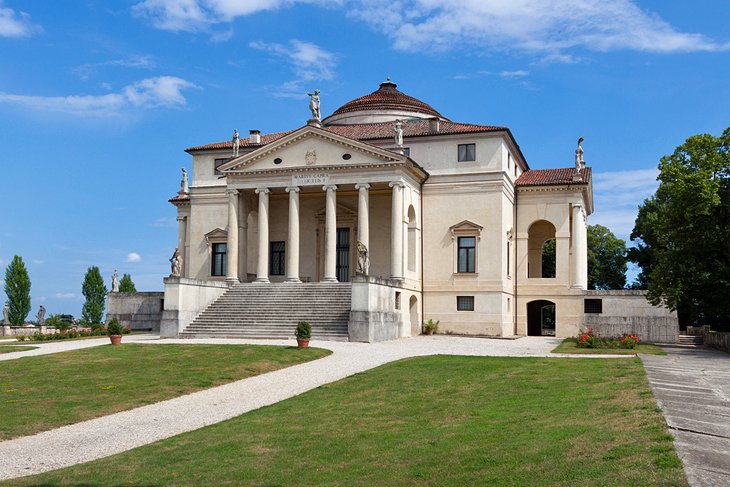
Connected to the nearby Villa Valmarana by a footpath - about a 10-minute walk - is the most recognized of all Palladio's buildings, Villa Almerico Capra, better known as La Rotonda. Commissioned by a priest as his country house upon his retirement from the Vatican, the villa was inspired by the Pantheon in Rome. In turn, it has inspired hundreds of later buildings the world over, including Thomas Jefferson's home, Monticello, in Virginia, USA.
The square structure is completely symmetrical, with a portico on each of the four sides, and crowned by a dome. Although it was designed and begun by Palladio about 1567, at his death in 1580, the building was completed by Vincenzo Scamozzi, who kept to the original plans except for some modifications to the dome.
The interior is decorated in elaborate frescoes, with trompe l'oeil architectural features - columns, niches, and capitals - on the walls. It is possible to visit the grounds and the interior on alternate days. Those with a particular interest in Palladio's work will find other villas easily reached on day trips from Vicenza.
Address: Via della Rotonda 45, Vicenza
Basilica di Monte Berico
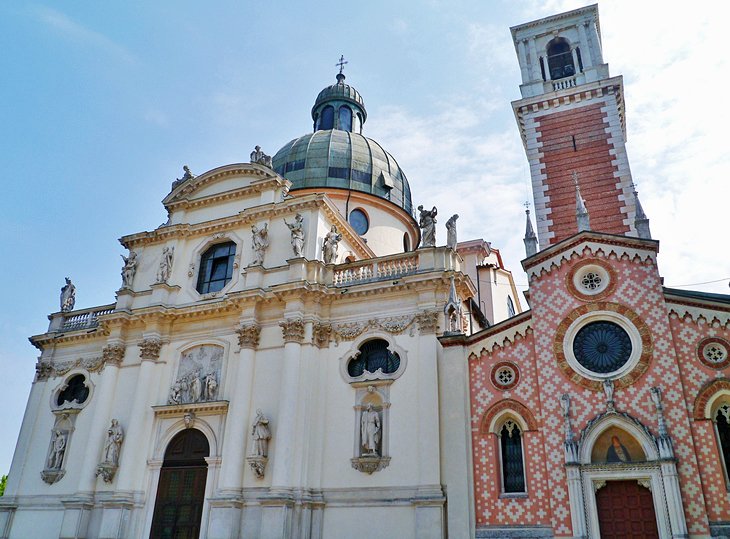
From the Villa Roi, on the southern outskirts of Vicenza, the Portici di Monte Berico, a series of arcades built in 1746, lead up to the Basilica di Monte Berico. This pilgrimage church was built by the Bologna architect C. Borella in 1668. The basilica's centralized plan is modeled on the Rotonda.
In the chapel to the right of the high altar is Lamentation by Bartolomeo Montagna (1500); in the refectory is his large Banquet of St. Gregory Magnus. There is an almost Byzantine feel to the interior, which is lit by votive candles around the high altar.
Two somewhat surprising collections are worth noticing in the refectory: fossils and the unusual needlework votive offerings in the vestibule. From the square in front of the church, Piazzale della Vittoria, are magnificent views of the city backed by the Pre-Alps, including Monte Pasubio and Monte Grappa.
Address: Viale X Giugno 87, Vicenza
Villa Valmarana (Ai Nani)
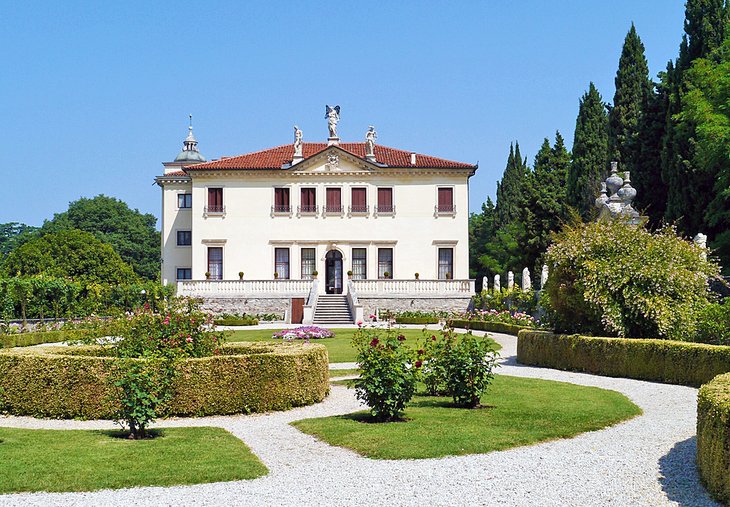
Behind high walls crowned with a series of stubby statues, the 17th-century Villa Valmarana is locally known as Ai Nani, a reference to the dwarfed statues on the walls. The magnificent frescoes, painted in 1757, adorning the residence and guest house are one of the main attractions for tourists.
Those in the main villa are by Giambattista Tiepolo and cover the entry and four ground-floor rooms with dramatic and heroic scenes from Roman, Greek, and Italian literature. By marked contrast, the frescoes done at the same time by Tiepolo's son Giandomenico, in the adjoining guest house, are light and airy scenes of peasant and town life. Both sets are very well preserved.
Address: Stradelli dei Nani 8, Vicenza
Official site: http://www.villavalmarana.com
Palazzo Leoni Montanari
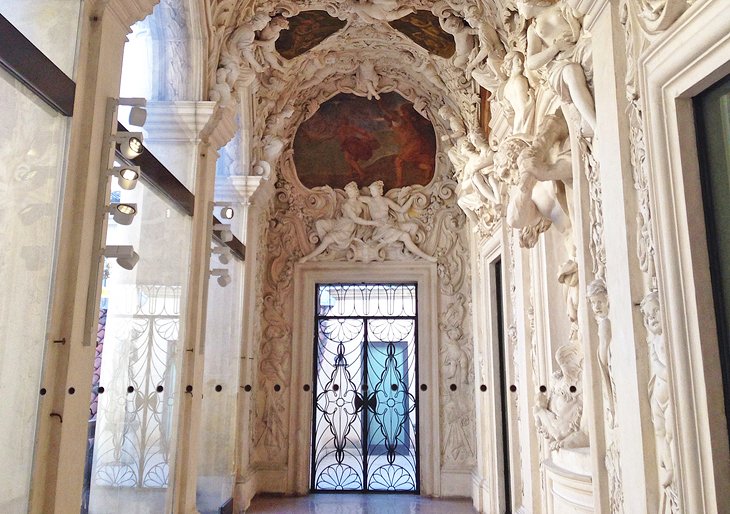
In contrast to the predominantly Palladian Renaissance style elsewhere in Vicenza, Palazzo Leoni Montanari is unabashedly late Baroque, and is appreciated as much for the lavishly decorated interior as for the priceless art it houses.
Cherubs and mythological creatures seem to peer down at visitors from every corner of the hallways and stairs: dragons slither around window arches, giants support door pediments, and grotesques leer beside fat little cherubs.
Amid all this are galleries of ancient Greek ceramics, 20th-century modernist works, and Venetian art of the 1700s, including an entire room of paintings by Pietro Longhi. The top floor is devoted to Russian icons, for its extent and quality perhaps the finest collection outside of Russia.
Address: Contrà Santa Corona, 25, 36100 Vicenza
Piazza dei Signori and Loggia del Capitaniato
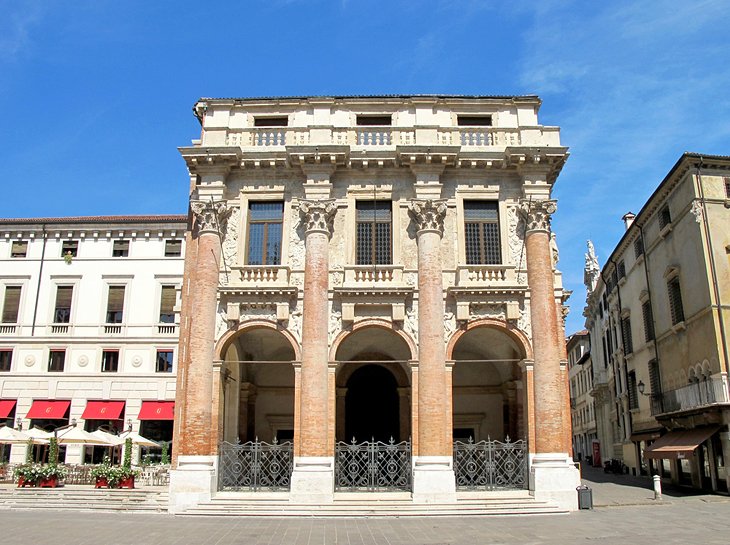
Piazza dei Signori was the site of the old Roman forum, with two columns from the Venetian period and the slender Torre di Piazza, a defensive tower built in 1174. Facing the Basilica Palladiana, which occupies an entire side of the piazza, is the Loggia del Capitaniato, now part of the Town Hall.
It was the residence of the Venetian governor, begun by Palladio in 1571 and cited as part of the UNESCO World Heritage Site that covers the city and surrounding Palladian villas. As a contrast to the white stone and largely unornamented facade of the basilica opposite, the loggia is richly decorated with carvings and contrasting colors.
Palazzo Chiericati (Museo Civico)
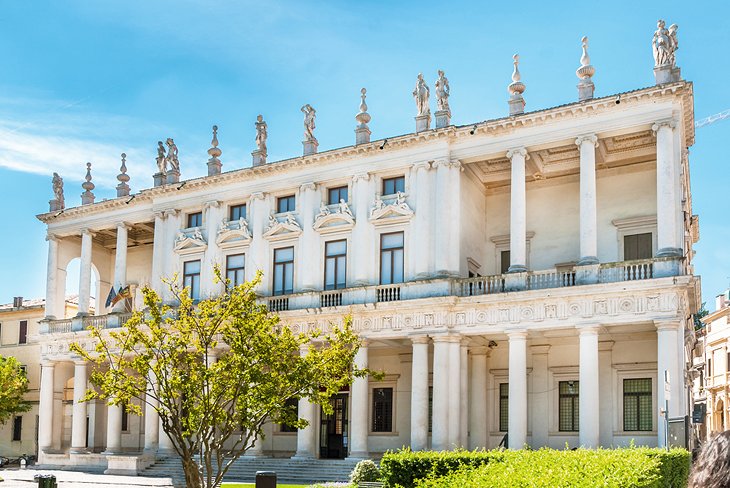
At the northeast end of the Corso Andrea Palladio is the Renaissance Palazzo Chiericati, one of Palladio's finest buildings and now home to the Museo Civico, Vicenza's municipal museum. On the ground floor are archeological collections, and on the main floor, a picture gallery displays the city's collection of paintings.
This contains major works by painters of the Vicenza school (such as Bartolomeo Montagna and Giovanni Buonconsiglio) and the best known Venetian masters, including Carpaccio, Veronese, Tintoretto, Tiepolo, and others.
Address: Piazza Matteotti 37-39, Vicenza
Official site: http://www.museicivicivicenza.it/en/
Santa Corona
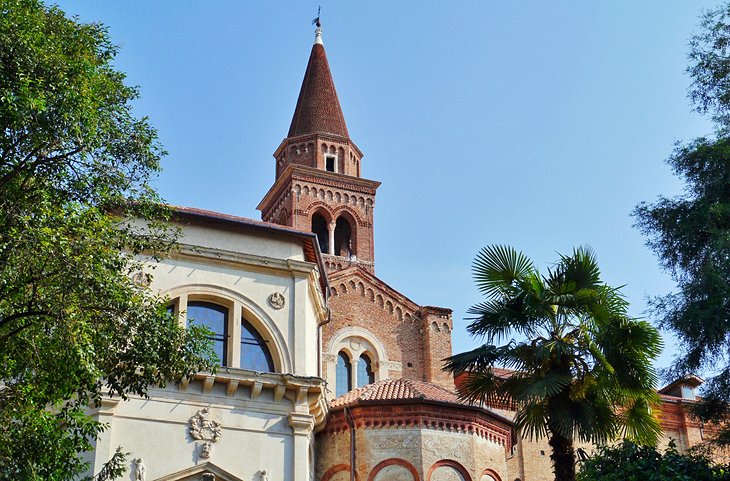
The Gothic church of Santa Corona was built in the 13th century to house a holy relic, a thorn from Christ's Crown of Thorns, and contains several notable paintings. The Baptism of Christ by Giovanni Bellini, from about 1500, is above the fifth altar on the left, and on the third altar on the right is Adoration of the Magi by Veronese.
But what draws most visitors is the church's 1576 Cappella Valmarana, a chapel believed to have been designed by Andrea Palladio, who is buried in the church.
Address: Contra Sant Corona 2, Vicenza
Corso Andrea Palladio
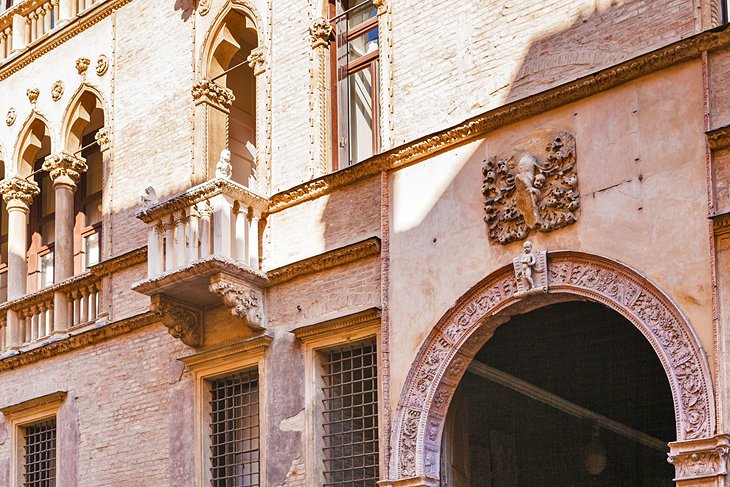
A little way northwest of the Piazza dei Signori is the main street of Vicenza, the Corso Andrea Palladio, lined with palaces, several of them designed by Palladio. Halfway along, you'll see the fine Palazzo del Comune, designed by Vincenzo Scamozzi and built in the early 17th century. Northeast of this is the Gothic Palazzo Da Schio, known as the Cà d'Oro, House of Gold. At the southwest end are more palaces, including Palazzo Bonin (No. 13) and Palazzo Zileri Dal Verme (No. 36).
The Corso ends in the Piazza Castello, location of the Porta Castello. To the left, on the shorter side of the square, the unfinished Palazzo Porto-Breganze was probably designed by Palladio and built by Vincenzo Scamozzi about 1600. Contra Porti, which intersects with Corso Andrea Palladio not far from Piazza dei Signori, is also lined by 14th-century Venetian mansions and several more of Palladio's.
Corso Andrea Palladio isn't just for lovers of Renaissance architecture; it's also the place to go shopping in Vicenza. You'll find stores of Italian designers and international brands, boutiques and gourmet food shops, as well as plenty of busy cafes and restaurants.
San Lorenzo
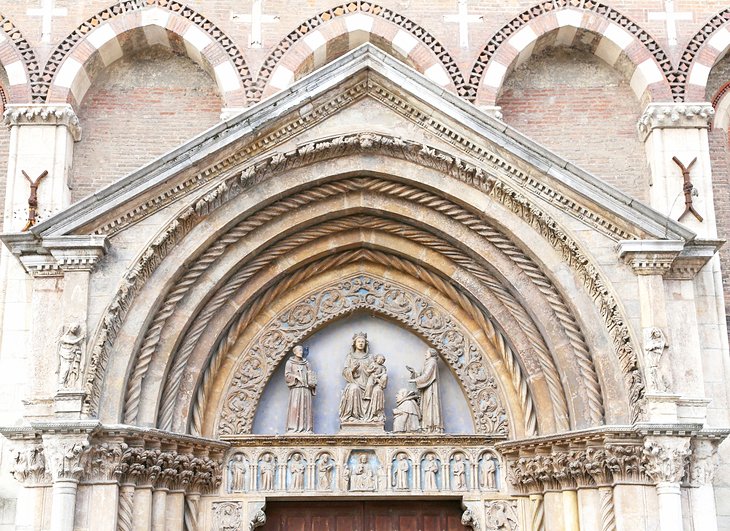
From Palazzo Valmarana, about midway along Corso Andrea Palladio, Via Fogazzaro runs northwest to the brick church of San Lorenzo. The Romanesque and Gothic church, built from 1280 to 1344, has a slender campanile and a beautiful main doorway.
In the fine interior are some impressive tombs and a fresco by Bartolomeo Montagna, The Beheading of St. Paul, from about 1500. Be sure to see the cloister adjoining the church, one of Vicenza's loveliest.
Address: Campo San Lorenzo, Vicenza
Cathedral
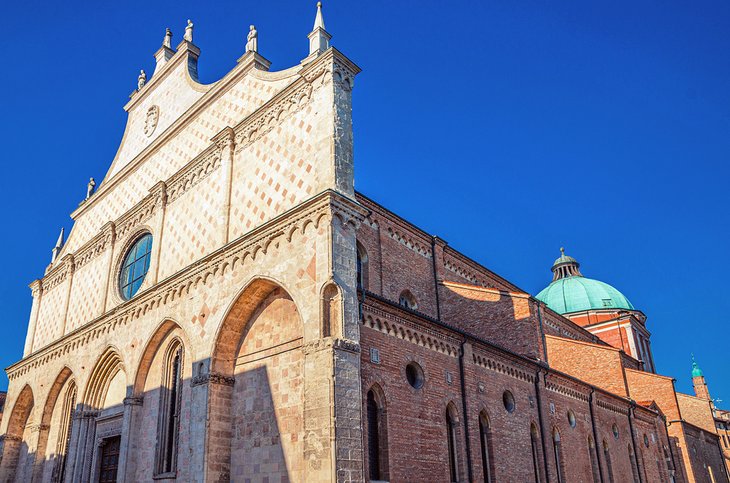
Via Garibaldi runs southwest to the Piazza del Duomo, on the north-side of which stands the cathedral, a Gothic structure of brick with a façade of white and red marble that was built in the 15th century and restored after World War II bombing. Inside is a 14th-century triptych by Lorenzo Veneziano.
Under the cathedral are the foundations of three earlier churches, and beneath the sacristy are the remains of a Roman road. On the southwest side of Piazza del Duomo, the Bishop's Palace has a Neoclassical façade of 1819.
Address: Piazza Duomo, Vicenza
Visit Villas around Vicenza
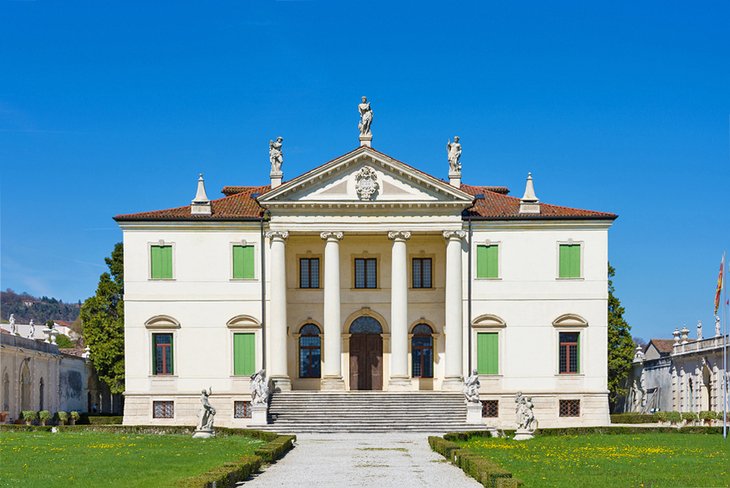
The countryside around Vicenza was a popular place for prominent families to build country villas in the 16th through 18th centuries. Several of these were designed by Andrea Palladio, others attributed to him, still others perhaps inspired by his designs.
Some can only be viewed from the outside, but several are open to tourists, and some of them have beautifully restored grounds and gardens. Several of them are on the UNESCO World Heritage list of Palladian villas.
Villa Godi Malinverni, north of Vicenza in Lonedo di Lugo, was built by Andrea Palladio in 1542, and it was decorated in frescoes by Gianbattista Zelotti, Battista del Moro, and Gualtiero Padovano. After touring the villa, you can stroll in the 17th-century gardens, filled with pools, fountains, and dozens of statues. The former barns have been renovated as a restaurant. Nearby Villa Piovene, also on the UNESCO list, is not open to tourists, but visible through its ornate gates.
Villa Trissino Marzotto sits in a park of lawns and large trees, some over two centuries old, and Italian gardens of hedges, topiary, terraces, flower beds, and avenues. A highlight is the double staircase that descends to a large octagonal fountain. The villa itself is open on summer Saturdays.
Eight kilometers west of Vicenza, in Montecchio Maggiore, the Palladian-style Villa Cordellina Lombardi, was built in the 1750s by architects Francesco Muttoni and Giorgio Massari. Rooms were frescoed by Giovanni Battista Tiepolo, the preeminent fresco artist of the time. The highlight is the magnificent two-story Salone del Tiepolo, with its monumental wall and ceiling frescoes.
The villa is set in formal gardens, with outbuildings surrounding several courtyards.
About 30 kilometers south of Vicenza, Villa Fracanzan Piovene was also built in the 18th-century and not designed by Palladio, but is well worth seeing for its beautiful rooms; its collections; and the formal garden with box hedges, grand avenues, and giant yews. Additional estate gardens are in their original form, with fruit trees, vegetables, and flowers.
The large Barchessa (barn) displays a collection of antique farm equipment and tools illustrating everyday rural life in the 18th century. The highlight of a tour is the villa's magnificent kitchen and its collection of antique copper pots and utensils.
Map of Tourist Attractions & Things to Do in Vicenza
Vicenza, Italy - Climate Chart
| Average minimum and maximum temperatures for Vicenza, Italy in °C | |||||||||||
| J | F | M | A | M | J | J | A | S | O | N | D |
| 6 -2 | 9 0 | 13 3 | 18 7 | 23 11 | 26 15 | 29 17 | 28 17 | 25 14 | 19 8 | 12 3 | 7 -1 |
| PlanetWare.com | |||||||||||
| Average monthly precipitation totals for Vicenza, Italy in mm. | |||||||||||
| 84 | 79 | 89 | 97 | 102 | 104 | 74 | 102 | 76 | 94 | 109 | 79 |
| Average minimum and maximum temperatures for Vicenza, Italy in °F | |||||||||||
| J | F | M | A | M | J | J | A | S | O | N | D |
| 43 28 | 48 32 | 55 37 | 63 44 | 72 52 | 79 59 | 84 63 | 82 61 | 76 56 | 65 47 | 53 37 | 44 30 |
| PlanetWare.com | |||||||||||
| Average monthly precipitation totals for Vicenza, Italy in inches. | |||||||||||
| 3.3 | 3.1 | 3.5 | 3.8 | 4.0 | 4.1 | 2.9 | 4.0 | 3.0 | 3.7 | 4.3 | 3.1 |
More Related Articles on PlanetWare.com
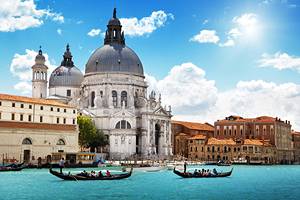
Places to Visit near Vicenza: The area around Vicenza is filled with some of the best places to visit in Italy, so you are spoiled for choices of nearby things to do. Vicenza is only 45 minutes from romantic Verona, and the multiple attractions of Venice are less than an hour away.
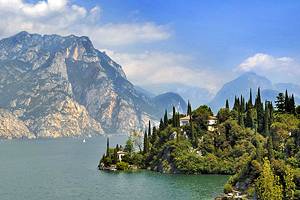
Exploring Northern Italy's Lakes: Vicenza is also a good starting point for discovering Italy's beautiful lake region. Begin with a drive around Lake Garda, surrounded by dramatic mountains, then head west to tour the gardens and villas around Lake Como. For even more ideas, see our article on the Tourist Attractions around Lake Maggiore & Easy Day Trips.




